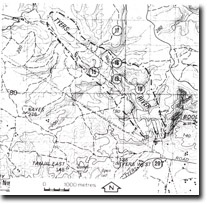16. Tyers Quarry
|
This information has been developed from the publications:
|
| Location: | 496812. 4.5 kilometres south-east of Moondarra Reservoir. | |
| Access: | Western extension of Rintouls Road via Traralgon-Walhalla Road. | |
Ownership: | Crown Land. | |
Geology/Geomorphology: | Tyers Quarry is excavated in massive Coopers Creek Limestone and the quarry face provides an excellent and easily accessible exposure in these Lower Devonian sediments. Although outcrop outside the quarry is poor, the gradation from Boola Formation mudstones through conglomerates to Coopers Creek Limestone can be traced. The limestone beds dip steeply to the west and are highly fossiliferous in parts. Stromatoporoids, tabulate and rugose corals are relatively common while brachiopods are rare. In addition, Tentaculite fossils found in this quarry are of importance in stratigraphic determinations. A complete species list of the fossil fauna at this locality is present in Philip (1962). | |
Significance: | Regional. Outcrops of the Coopers Creek Limestone only occurs in the Tyers River area. This site provides an easily accessible and representative section. | |
Management: | Parts of the quarry face are being overgrown by blackberries. Occasional grading of the cliff bottom scree would enhance the value of the site. Future mining at this site would need to preserve at least some of the limestone conglomerate sequence. | |
References: | Philip, G.M., 1962. The palaeontology and stratigraphy of the Siluro-Devonian sediments of the Tyers area, Gippsland, Victoria. Proc. R. Soc. Vict., 75, pp.123-246. Cooper, B.J., 1973. Discovery of Tentaculites in the limestone at Tyers, Gippsland. Vict. Nat., 90, pp. 192-194. | |



